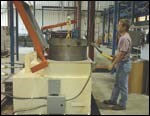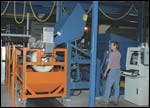Specialty Finishing Boosts Customer Satisfaction
Carefully chosen wet processes allow a mechanical finisher to add value...
Founded in 1961, Rapids Tumble Finish (RTF; Eaton Rapids, MI) began business by providing tumble finishing services. The company later added vibratory processing for deburring, cleaning, burnishing, radiusing, and finally, in the late-1980s, media blasting services.
RTF’s only facility is in central lower Michigan. Its customer base is geographically widespread but heavily automotive. If you think this doesn’t sound like a strategy for success right now, think again. In April, 2005, the company passed a notable milestone: not only did it post record sales, but it did so following 75 quarters of steady growth. Sales in this record month came from the same diverse sources as they always had: longstanding customers, new customers, OEMs, Tier 1s, job shops that RTF works with reciprocally—and from across the Atlantic Ocean.
The company’s latest expansion of its capabilities involves two specialty finishing technologies, black oxide and zinc phosphate. And, RTF already has customers lined up for both processes.
President and Owner Loren Cowles believes that the factors that allowed his company to thrive as a supplier of surface enhancement will allow it to be equally successful with surface coating. Chief among those factors is a strongly proactive stance when it comes to quality of incoming parts.
“Quality really does begin before anything happens at all, not after processing or in-process,” Cowles says. “Determining exactly what you’re receiving, including what’s on those components, is a policy commitment. It helps protect your chemistry, but more than that, it’s a big step toward getting the job right the first time.”
A related factor is quality certifications, Cowles believes. “ISO, QSB and other benchmarks give us credentials when we need them and the flexibility to choose work that best fits our capabilities,” he says.
Equipment is also important: RTF designs and builds most of its own, from inspection gages to loaders for Wheelabrators to parts dumpers and rust inhibiting equipment. The company also operates its own fleet of trucks to more closely control deliveries.
Chemistry is critical, too. RTF processes ferrous and nonferrous product using the same steel or ceramic media, changing the liquid compound according to the process requirement. Often, RTF custom-blends compounds to achieve a more precise result.
Finally, there’s the factor of job mix. One ongoing program involves surface repair of high-value components produced in Europe.
“Processing that requires us taking a 15 or 20 micro-finish down to 4 or 5 is an excellent fit for us,” explains Cowles. “We’re geared to a 0.0002 inch standard, and we can handle close tolerances. Our philosophy has been to focus on high-value parts—particularly ones with complex shapes—turn them around fast and build customer loyalty. Customers more often call on us to solve problems, such as dimensional repair or resurfacing of rusted parts made in Asia, than to just provide a service.”
This is particularly true with work Cowles describes as reverse process engineering. “It’s really vendor engineering, in that we spec to the OEMs, including one automaker, precisely how much material our surfacing will take off and therefore, what to send us in terms of product size. While this is not the norm, it has proven very effective in producing large volumes of parts that are exceptionally consistent in both dimensions and microfinish.”
Vertical Integration
The new phosphate and black oxide line clearly creates opportunities to do more with parts that are already surfaced, a value-added service that Cowles believes will benefit customers in lower costs, better scheduling and reduced transportation. “We surveyed our service area and determined that zinc phosphate and black oxide were key,” he explains.
Black oxide is not new, of course, and its applications in traditional markets—automotive, for example—are not necessarily expanding at this time. But it has gained a cost advantage over rival technologies, according to Cowles, who says his company has identified some non-traditional uses for black oxide that can offer advantages for customers. “And of course, we like black oxide for the one thing that it does not do—and that is change parts dimensions,” he adds.
In considering black oxide and zinc phosphate chemistries, RTF looked for products with a performance history that would be stable, simple to operate and not create headaches with waste treatment. Cowles found that combination in a family of products manufactured by Heatbath Corp. (Springfield, MA).
“The goal was to turn out a coated product that is as good and as consistent as our deburred ones,” Cowles explains. “Heatbath’s technical sales representative in this region, Jim Knape, had exactly the expertise we needed, not just with chemistry, but with equipment recommendations as well.”
Knape worked with RTF first to determine the size and scope of the equipment that would be needed. “A couple of the big equipment makers came off as rigid and not very good at listening,” Cowles recalls. “So, we considered numerous configurations and did our own preliminary drawings. With his years of experience, [Knape’s] help was invaluable. We jointly decided on a layout featuring parallel process lines and a cleaning stage that allows parts headed for both processes to be cleaned together.”
The line was designed to accommodate a standard maximum barrel size. Parts arrive in standard tubs and one tub equals a barrel. So, when loads emerge, the tub is just refilled. Barrels are approximately 2,000 lb capacity, but there are exceptions—muffler caps being one—and the line has to be flexible enough to accommodate those.
The equipment was engineered to provide five major finishing options: pickle and oil, black oxide, heavy zinc phosphate, black zinc phosphate and calcium-modified phosphate. It offers four options for topcoats: water-displacing oil for maximum corrosion protection, water-displacing oil for dry-to-the-touch, water-soluble oil and water-based rust inhibitor.
The system offers the flexibility of rack or barrel parts processing; gas dryers are used for racked parts, barrel-processed parts are dried in spin dryers. Barrels are designed to accommodate separation chambers that can empty independently, so two different parts can be run simultaneously.
The system will run standard and custom process cycles; chemical analysis and process control are computerized for ease of use and to provide process documentation. With each load, the line generates a process sheet indicating the process cycle used, the tank temperatures and relevant chemical parameters.
RTF’s selection of products was guided by factors that included cost, process repeatability, tech support and waste treatment. The U.S. Environmental Protection Agency’s Region 5, and Eaton County in particular, heavily regulate effluent containing strong alkalis, corrosive solids and oxidizing agents, and the costs of compliance can make processes uncompetitive if products are not chosen carefully.
Chemistry
For the cleaner, RTF selected Heatbath’s Uni Kleen 1293, a caustic, heavy-duty soak cleaner originally developed to eliminate solvent pre-cleaning in electrocoating operations. The product is effective for the complex shapes RTF often processes and quickly removes polishing, buffing and forming compounds.
The acid pickle stage uses Heatbath Rust Remover 4, a liquid acid pretreatment for pickling and descaling ferrous metals. It’s used at ambient temperature and contains an inhibitor to prevent base metal attack where long immersion is needed to remove heavy scale, such as with the parts made in
Asia.
For black oxide chemistry, RTF chose Heatbath’s Pentrate Ultra L, a “deep black” formula that produces a minimal build-up of colloidal iron in the working bath to minimize the risk of superficial red, brown or green films. Of particular importance to RTF was the incorporation of a wetting agent, which greatly reduces chemical loss due to drag out and thus minimizes the costs of both product and waste treatment. RTF included automatic chemical feed and water additions for this tank.
On the phosphate side, the Black Pre-Dip stage uses Phos Dip BZP-4, a pre-phosphate coating, which can be followed by zinc or manganese phosphate. RTF will also provide manganese phosphate processing if customers request it.
The heavy (2,000 mg/sq ft) zinc phosphate chosen for the automotive, off-highway, machinery and other heavy-service components RTF processes is Phos Dip 1263, a product with a high tolerance for iron in solution. This coating produces high uniformity of parts coverage and minimal sludge formation in the working bath.
For micro zinc phosphating, RTF installed Phos Dip R-2-LT, a calcium-modified process that deposits a microcrystalline base and is ideal for pre-paint.
One of several topcoat options for use over phosphate coatings is Heatbath Rust Inhibitor 1438, a nitrite-free, solvent-free water-based product developed for in-plant rust protection of steel products.
Heatbath Lab Oil 100 is a water-soluble, emulsion-type rust preventative that provides high levels of corrosion protection, good emulsification characteristics and low toxicity. It is barium-free and dry to the touch when applied over phosphate or black oxide.
Where maximum corrosion protection is needed, RTF chose a thin-film rust preventative, Heatbath Pen Dip Super. Developed specifically for black oxide and phosphate-coated components, the solvent-based rust-inhibiting oil has excellent water displacing properties. It can also be used to protect highly finished parts during
manufacture.
The other option for water-displacing oil selected by RTF is Pen Dip A, which produces an extremely dry film and allows immediate shipping.
The first parts processed on the new RTF line were nuts, tubes and muffler caps. All met customer specifications for surface finish and for surface coating.
Related Content
Possibilities From Electroplating 3D Printed Plastic Parts
Adding layers of nickel or copper to 3D printed polymer can impart desired properties such as electrical conductivity, EMI shielding, abrasion resistance and improved strength — approaching and even exceeding 3D printed metal, according to RePliForm.
Read MoreInnovation in Plating on Plastic
Plating on advanced plastics solution offers improved adhesion, temperature resistance and cost savings.
Read MoreNanotechnology Start-up Develops Gold Plating Replacement
Ag-Nano System LLC introduces a new method of electroplating based on golden silver nanoparticles aimed at replacing gold plating used in electrical circuits.
Read MoreAn Overview of Electroless Nickel Plating
By definition, electroless plating is metal deposition by a controlled chemical reaction.
Read MoreRead Next
A ‘Clean’ Agenda Offers Unique Presentations in Chicago
The 2024 Parts Cleaning Conference, co-located with the International Manufacturing Technology Show, includes presentations by several speakers who are new to the conference and topics that have not been covered in past editions of this event.
Read MoreDelivering Increased Benefits to Greenhouse Films
Baystar's Borstar technology is helping customers deliver better, more reliable production methods to greenhouse agriculture.
Read MoreEpisode 45: An Interview with Chandler Mancuso, MacDermid Envio Solutions
Chandler Mancuso, technical director with MacDermid Envio discusses updating your wastewater treatment system and implementing materials recycling solutions to increase efficiencies, control costs and reduce environmental impact.
Read More
















.jpg;maxWidth=300;quality=90)










